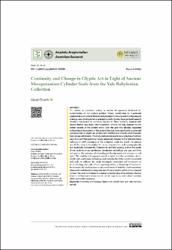| dc.contributor.author | Öztürk, Güzel | |
| dc.date.accessioned | 2024-12-06T07:27:54Z | |
| dc.date.available | 2024-12-06T07:27:54Z | |
| dc.date.issued | 2024 | en_US |
| dc.identifier.issn | 0569-9746 / 2667-629X | |
| dc.identifier.uri | https://doi.org/10.26650/anar.2024.30.1434606 | |
| dc.identifier.uri | https://hdl.handle.net/20.500.12462/15467 | |
| dc.description.abstract | The advent of cuneiform writing in ancient Mesopotamia facilitated the reconstruction of the region's political history, contributing to a profound understanding of societal lifestyles and perceptions. Among extant archaeological artefacts, seals, distinguished as exemplary small artworks, have garnered research attention comparable to cuneiform documents. These artefacts, adorned with diverse themes and styles, offer a narrative richness not fully captured by the written records of the ancient world. Over the past two decades, expanded archaeological excavations in the ancient Near East have significantly augmented our knowledge of glyptic art, yielding well-stratified and securely dated examples from various settlements. This study meticulously examines a collection of cylinder seals of ancient Mesopotamian origin, generously donated to the Yale Babylonian Collection in 2016, belonging to the antiquities trader E.S. David. The primary aim of this study is to analyse the scenes engraved on seals iconographically and stylistically. Concurrently, it delves into technical aspects, such as the variety of raw materials in seal production, production technology, seal size, and form, and queries the existence of chronological developments and changes in seal styles. This multifaceted approach unveils insights into the worldview, culture, artistic style, mythology, technology, and everyday life of the societies associated with seals. In addition, this study investigates similarities and innovations in the technology and style of seal engraving within a chronological framework. Furthermore, this study focuses on the examination of similarities and innovations observed in both the technology and style of seal engraving within a chronological context. This study contributes to a deeper understanding of the intricate interplay between technological advancements, artistic expression, and cultural evolution within ancient Mesopotamia. | en_US |
| dc.description.sponsorship | Koc University Suna Inan Kimath;rac Mediterranean Civilizations Research Center (AKMED) KU AKMED 2023/P.1078 | en_US |
| dc.language.iso | eng | en_US |
| dc.publisher | Istanbul Universitesi | en_US |
| dc.relation.isversionof | 10.26650/anar.2024.30.1434606 | en_US |
| dc.rights | info:eu-repo/semantics/openAccess | en_US |
| dc.rights.uri | http://creativecommons.org/licenses/by-nc/3.0/us/ | * |
| dc.subject | Continuity and Change | en_US |
| dc.subject | Glyphic Art | en_US |
| dc.subject | Jemdet Nasr and Early Dynastic periods | en_US |
| dc.title | Continuity and change in glyptic art in light of ancient mesopotamian cylinder seals from the yale babylonian collection | en_US |
| dc.type | article | en_US |
| dc.relation.journal | Anadolu Araştırmaları | en_US |
| dc.contributor.department | Ayvalık Meslek Yüksekokulu | en_US |
| dc.contributor.authorID | 0000-0002-0548-9066 | en_US |
| dc.identifier.issue | 30 | en_US |
| dc.identifier.startpage | 39 | en_US |
| dc.identifier.endpage | 66 | en_US |
| dc.relation.publicationcategory | Makale - Uluslararası Hakemli Dergi - Kurum Öğretim Elemanı | en_US |




















